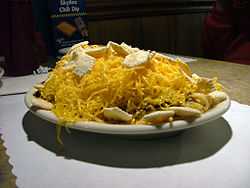Cincinnati chili
| Cincinnati chili | |
|---|---|
| Chili con carne | |
 A Cincinnati chili 4-way garnished with oyster crackers | |
| Alternative name(s): | |
| Cincinnati-style chili | |
| Place of origin: | |
| United States | |
| Region or state: | |
| Cincinnati | |
| Main ingredient(s): | |
| Chili con carne, spice (cinnamon, cloves, allspice or chocolate) | |
| Recipes at Wikibooks: | |
|
| |
| Media at Wikimedia Commons: | |
|
|
Cincinnati chili (or “Cincinnati-style chili”) is a regional style of chili con carne characterized by the use of seasonings such as cinnamon, cloves, allspice or chocolate. It is commonly served over spaghetti or as a hot dog sauce, and is normally of a thin, sauce-like consistency, unlike most chili con carne. While served in many regular restaurants, it is most often associated with several restaurant chains, such as Empress Chili, Skyline Chili, Gold Star Chili, Camp Washington Chili, Pleasant Ridge Chili and Dixie Chili. Restaurant locations are found pervasively in greater Cincinnati with franchise locations also throughout Ohio and in Kentucky, Indiana, and Florida. Restaurants that feature Cincinnati chili are frequently called “chili parlors”.
According to the Greater Cincinnati Convention and Visitors Bureau, Cincinnatians consume more than two million pounds of chili each year, topped by 850,000 pounds of shredded cheddar cheese.[1] Each September, the city celebrates “Chilifest” at Yeatman's Cove on the Ohio River, with food and entertainment.[2]
Cincinnati chili has earned the praise of national food critics Jane and Michael Stern, who raved "As connoisseurs of blue-plate food, we consider Cincinnati chili one of America's quintessential meals."[3]
Cincinnati chili basics
Ordering Cincinnati chili is based on this ingredient series: chili, spaghetti, grated cheddar cheese, diced onions, and kidney beans.[4] The number before the "way" of the chili determines which ingredients are included in each chili order.[2] Thus, customers can order a:
- Bowl: chili in a bowl
- Two-way: chili and spaghetti
- Three-way: chili, spaghetti, and cheese
- Four-way: chili, spaghetti, cheese, and onions
- Five-way: chili, spaghetti, cheese, onions, and beans
and optionally, the:
- Four-way bean: chili, spaghetti, cheese, and beans (beans substituted for the onions)
The preceding basic menu is entirely traditional. Some chili parlors, notably Skyline and Gold Star, have altered the traditional menu method, declaring on their menus that a Four-way is chili, spaghetti, cheese, and either onions or beans. Other parlors have added ingredients to the traditional mix. For example, Dixie Chili offers a “Six-way” with the addition of garlic.[5] Oyster crackers are usually served with Cincinnati chili,[6] and a mild hot sauce is frequently used as an optional topping.
When served on a Coney style hot dog, dubbed the “Cheese Coney", the chili is also topped with grated cheddar cheese. The default coney also includes mustard and a small amount of onion.[7]
Origins and history
Cincinnati chili seems to have originated with one or more immigrant restaurateurs from Macedonia who were trying to broaden their customer base by moving beyond narrowly ethnic styles of cuisine. Tom and John Kiradjieff began serving the chili in 1922 at their hot dog stand, next to a burlesque theater called the Empress, after which their Empress chili parlor took its name.[4] Tom Kiradjieff invented the style by modifying a traditional stew and serving it over hot dogs and spaghetti. The style has since been copied and modified by many other restaurant proprietors.
Empress was the main chili parlor in Cincinnati until 1949, when a former Empress employee and Greek immigrant, Nicholas Lambrinides, started another chili restaurant called Skyline Chili.[4] Gold Star Chili came along in 1965, started by the four Daoud brothers who were originally from Jordan.[4]
References
- ↑ Woellert, Dann (Apr 16, 2013). The Authentic History of Cincinnati Chili. The History Press. p. 10. Retrieved 2013-05-18.
- ↑ 2.0 2.1 Cliff Lowe. "The Life and Times of Chili: Cincinnati Chili". Retrieved 2007-02-03.
- ↑ "Cincinnati Chili: An Homage To Our Hometown Obsession". Cincinnati Magazine. Jul 1999. p. 43. Retrieved 2013-05-19.
- ↑ 4.0 4.1 4.2 4.3 Herrmann Loomis, Susan (16 April 1989), "Fare of the County; A City's Romance With a Bowl of Chili", New York Times, retrieved 16 September 2011
- ↑ Dixie Chili & Deli, Menu, retrieved 16 September 2010
- ↑ Stern, Jane (Jun 4, 2009). 500 Things to Eat Before It's Too Late: and the Very Best Places to Eat Them. Houghton Mifflin Harcourt. p. 243. Retrieved 2013-05-18.
- ↑ "Cincinnati Chili: Pass the Tabasco". Fodor's. Retrieved 2009-08-19.